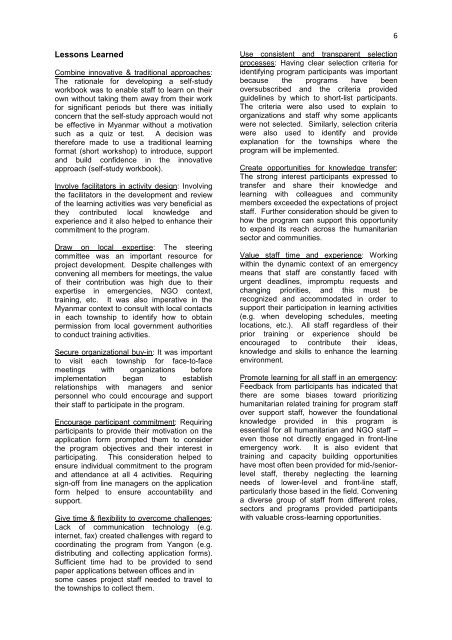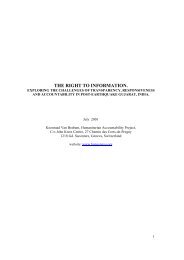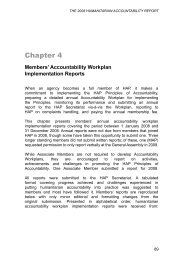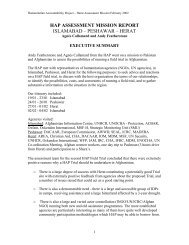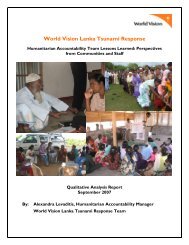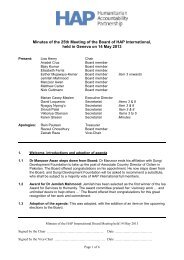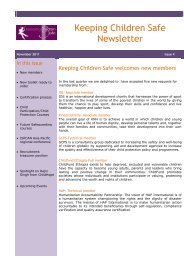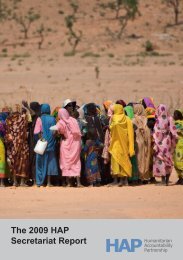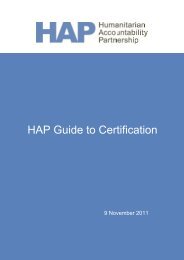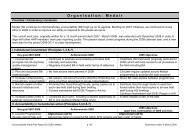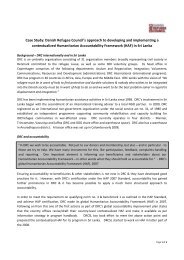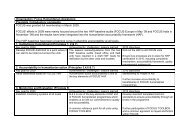Disaster Preparedness Program Case Study ... - HAP International
Disaster Preparedness Program Case Study ... - HAP International
Disaster Preparedness Program Case Study ... - HAP International
You also want an ePaper? Increase the reach of your titles
YUMPU automatically turns print PDFs into web optimized ePapers that Google loves.
Lessons Learned<br />
Combine innovative & traditional approaches:<br />
The rationale for developing a self-study<br />
workbook was to enable staff to learn on their<br />
own without taking them away from their work<br />
for significant periods but there was initially<br />
concern that the self-study approach would not<br />
be effective in Myanmar without a motivation<br />
such as a quiz or test. A decision was<br />
therefore made to use a traditional learning<br />
format (short workshop) to introduce, support<br />
and build confidence in the innovative<br />
approach (self-study workbook).<br />
Involve facilitators in activity design: Involving<br />
the facilitators in the development and review<br />
of the learning activities was very beneficial as<br />
they contributed local knowledge and<br />
experience and it also helped to enhance their<br />
commitment to the program.<br />
Draw on local expertise: The steering<br />
committee was an important resource for<br />
project development. Despite challenges with<br />
convening all members for meetings, the value<br />
of their contribution was high due to their<br />
expertise in emergencies, NGO context,<br />
training, etc. It was also imperative in the<br />
Myanmar context to consult with local contacts<br />
in each township to identify how to obtain<br />
permission from local government authorities<br />
to conduct training activities.<br />
Secure organizational buy-in: It was important<br />
to visit each township for face-to-face<br />
meetings with organizations before<br />
implementation began to establish<br />
relationships with managers and senior<br />
personnel who could encourage and support<br />
their staff to participate in the program.<br />
Encourage participant commitment: Requiring<br />
participants to provide their motivation on the<br />
application form prompted them to consider<br />
the program objectives and their interest in<br />
participating. This consideration helped to<br />
ensure individual commitment to the program<br />
and attendance at all 4 activities. Requiring<br />
sign-off from line managers on the application<br />
form helped to ensure accountability and<br />
support.<br />
Give time & flexibility to overcome challenges:<br />
Lack of communication technology (e.g.<br />
internet, fax) created challenges with regard to<br />
coordinating the program from Yangon (e.g.<br />
distributing and collecting application forms).<br />
Sufficient time had to be provided to send<br />
paper applications between offices and in<br />
some cases project staff needed to travel to<br />
the townships to collect them.<br />
Use consistent and transparent selection<br />
processes: Having clear selection criteria for<br />
identifying program participants was important<br />
because the programs have been<br />
oversubscribed and the criteria provided<br />
guidelines by which to short-list participants.<br />
The criteria were also used to explain to<br />
organizations and staff why some applicants<br />
were not selected. Similarly, selection criteria<br />
were also used to identify and provide<br />
explanation for the townships where the<br />
program will be implemented.<br />
Create opportunities for knowledge transfer:<br />
The strong interest participants expressed to<br />
transfer and share their knowledge and<br />
learning with colleagues and community<br />
members exceeded the expectations of project<br />
staff. Further consideration should be given to<br />
how the program can support this opportunity<br />
to expand its reach across the humanitarian<br />
sector and communities.<br />
Value staff time and experience: Working<br />
within the dynamic context of an emergency<br />
means that staff are constantly faced with<br />
urgent deadlines, impromptu requests and<br />
changing priorities, and this must be<br />
recognized and accommodated in order to<br />
support their participation in learning activities<br />
(e.g. when developing schedules, meeting<br />
locations, etc.). All staff regardless of their<br />
prior training or experience should be<br />
encouraged to contribute their ideas,<br />
knowledge and skills to enhance the learning<br />
environment.<br />
Promote learning for all staff in an emergency:<br />
Feedback from participants has indicated that<br />
there are some biases toward prioritizing<br />
humanitarian related training for program staff<br />
over support staff, however the foundational<br />
knowledge provided in this program is<br />
essential for all humanitarian and NGO staff –<br />
even those not directly engaged in front-line<br />
emergency work. It is also evident that<br />
training and capacity building opportunities<br />
have most often been provided for mid-/seniorlevel<br />
staff, thereby neglecting the learning<br />
needs of lower-level and front-line staff,<br />
particularly those based in the field. Convening<br />
a diverse group of staff from different roles,<br />
sectors and programs provided participants<br />
with valuable cross-learning opportunities.<br />
6


